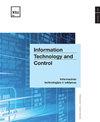Research on the Prediction Model of Chinese Tax Revenue Based on GM(1,1) and LSSVM
IF 2
4区 计算机科学
Q3 AUTOMATION & CONTROL SYSTEMS
引用次数: 0
Abstract
Abstract: In view of the complex influencing factors of tax revenue, the highly non-linear relationship among the influencing factors and the difficulty in predicting tax revenue, this paper proposes to use GM (1, 1) Combined with LSSVM, and it calculates the tax forecasting of China. This paper selects the proportion of the first industry, the ratio of import and export trade to GDP, GDP, the number of urban employment population, the proportion of residents' disposable income and tax revenue in fiscal revenue as the influencing factors, and uses GM (1, 1) and LSSVM respectively to predict the tax revenue of our country, establishes the quadratic programming model to determine the optimal combination weight for the formation of the combination predicting model of tax revenue in our country, make an empirical analysis with the tax revenue of our country from 2000 to 2018 as the research object, and compare the prediction results with LSSVM model, GM (1,1) model and improved GM (1,1) model. The results show that the prediction model of China's tax revenue based on GM (1,1) and LSSVM has a high fitting accuracy with the test set, which can reflect the complex non-linear relationship between various factors. It is of great significance for the development of prediction on Chinese tax revenue and the formulation of a scientific and effective national financial budget.基于 GM(1,1) 和 LSSVM 的中国税收收入预测模型研究
摘要:针对税收收入影响因素复杂、各影响因素之间高度非线性关系以及税收收入预测难度大等问题,本文提出采用GM(1,1)结合LSSVM,对我国税收预测进行计算。本文选取第一产业比重、进出口贸易占 GDP 比重、GDP、城镇就业人口数、居民可支配收入和税收收入占财政收入比重作为影响因素,分别利用 GM(1,1)和 LSSVM 对我国税收收入进行预测、建立二次编程模型,确定形成我国税收收入组合预测模型的最优组合权重,以我国2000-2018年税收收入为研究对象进行实证分析,并与LSSVM模型、GM(1,1)模型和改进的GM(1,1)模型的预测结果进行比较。结果表明,基于GM(1,1)和LSSVM的我国税收收入预测模型与测试集的拟合精度较高,能够反映各因素之间复杂的非线性关系。这对中国税收预测的发展和制定科学有效的国家财政预算具有重要意义。
本文章由计算机程序翻译,如有差异,请以英文原文为准。
求助全文
约1分钟内获得全文
求助全文
来源期刊

Information Technology and Control
工程技术-计算机:人工智能
CiteScore
2.70
自引率
9.10%
发文量
36
审稿时长
12 months
期刊介绍:
Periodical journal covers a wide field of computer science and control systems related problems including:
-Software and hardware engineering;
-Management systems engineering;
-Information systems and databases;
-Embedded systems;
-Physical systems modelling and application;
-Computer networks and cloud computing;
-Data visualization;
-Human-computer interface;
-Computer graphics, visual analytics, and multimedia systems.
 求助内容:
求助内容: 应助结果提醒方式:
应助结果提醒方式:


